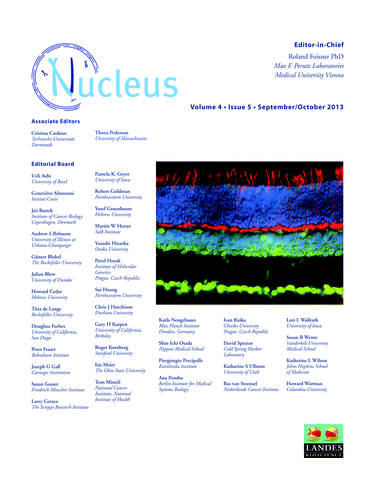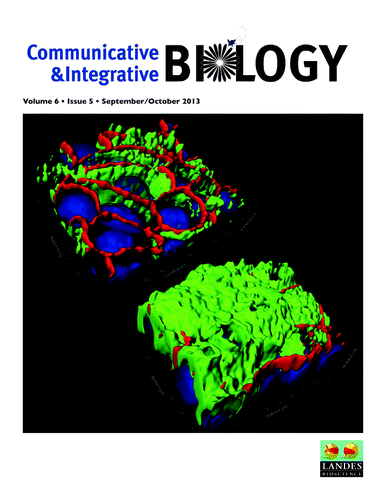Abstract
Transcriptional regulation at the yeast nuclear envelope
Dosage compensation in Drosophila requires Topoisomerase II function
Toxin-antitoxin systems: Biology, identification, and application
Sequence similarities between plant viruses and human miRs
Transcriptional regulation at the yeast nuclear envelope
Babett Steglich, Shelley Sazer, and Karl Ekwall
The spatial organization of the genome inside the nucleus affects many nuclear processes, such as DNA replication, DNA repair, and gene transcription. In metazoans, the nuclear periphery harbors mainly repressed genes that associate with the nuclear lamina. A recent review by Dr Karl Ekwall and colleagues discusses how peripheral positioning is connected to transcriptional regulation in yeasts. Tethering of reporter genes to the nuclear envelope was found to result in transcriptional silencing. Similarly, repression of the silent mating type loci and subtelomeric genes is influenced by their position close to the nuclear envelope. In contrast, active genes are bound by nucleoporins and inducible genes associate with the nuclear pore complex upon activation. Taken together, these findings portray the nuclear envelope as a platform for transcriptional regulation, both through activation at nuclear pores and silencing at the nuclear envelope.Citation1 .
https://www.landesbioscience.com/journals/nucleus/article/26394/
Dosage compensation in Drosophila requires Topoisomerase II function
Simona Cugusi, Edward Ramos, Huiping Ling, Ruth Yokoyama, Kevin M Luk, and John C Lucchesi
Dosage compensation is an epigenetic mechanism that normalizes gene expression from unequal copy numbers of sex chromosomes. Different organisms have evolved alternative molecular solutions to this task. In Drosophila, dosage compensation is mediated by the MSL (male-specific lethal) complex, which binds numerous sites on the X-chromosome in males and enhances the transcriptional rate of a substantial number of X-linked genes. In a new study, Dr John Lucchesi and co-workers found that topoisomerase II (Topo II) is enriched on dosage-compensated genes, to which it is recruited by association with the MSL complex, in excess of the amount that is present on autosomal genes with similar transcription levels. Using a plasmid model, the authors showed that Topo II is required for proper dosage compensation and that compensated chromatin is topologically different from non-compensated chromatin. This difference, which is not the result of the enhanced transcription level due of X-linked genes and which represents a structural modification intrinsic to the DNA of compensated chromatin, requires the function of Topo II. These results suggest that Topo II is an integral part of the mechanistic basis of dosage compensation.Citation2 .
https://www.landesbioscience.com/journals/transcription/article/26185/
Toxin-antitoxin systems: Biology, identification, and application
Simon J Unterholzner, Brigitte Poppenberger, and Wilfried Rozhon
Toxin-antitoxin (TA) systems are small genetic elements composed of a toxin gene and its cognate antitoxin. The toxins of all known TA systems are proteins while the antitoxins are either proteins or non-coding RNAs. TA systems typically act on crucial cellular processes, including translation, replication, cytoskeleton formation, membrane integrity, and cell wall biosynthesis. A recent review by Dr Wilfried Rozhon and colleagues provides a brief description of how TA systems are composed at the molecular level, highlights novel findings about the action of TA toxins on their cellular targets, and discusses functions proposed for TA systems. In addition, approaches for identification and characterization of putative TA systems are described. A special focus of this review is also the application of TA systems in biotechnology and basic research. Finally, the authors discuss the potential of TA systems for combating pathogens. .
https://www.landesbioscience.com/journals/mge/article/26219/
Sequence similarities between plant viruses and human miRs
Jovan D Rebolledo-Mendez, Radhika A Vaishnav, Nigel G Cooper, and Robert P Friedland
Micro-RNAs (miRs) regulate the expression of cellular and tissue phenotypes at a post-transcriptional level through a complex process involving complementary interactions between miRs and messenger-RNAs (mRNAs). Similar nucleotide interactions have been shown to occur as cross-kingdom events; for example, between plant viruses and plant miRs and also between animal viruses and animal miRs. In a recent study, Dr Robert Friedland and colleagues expand this view to look for cross-kingdom similarities between plant virus and human miR sequences. The authors developed a sequence processing pipeline, where data are filtered and carefully curated to allow for rational selection of candidate plant virus–human miR interactions to be used for future bench assays of function. Initial analyses demonstrated that plant viruses contain nucleotide sequences, which exactly match the seed sequences of human miRs in both parallel and anti-parallel directions. For example, the bean common mosaic virus strain NL4 from Colombia contains sequences that match exactly the seed sequence for miR of the hsa-mir-1226 in the parallel direction, which suggests a cross-kingdom conservation. Similarly, the rice yellow stunt viral cRNA contains a sequence that is an exact match in the anti-parallel direction to the seed sequence of hsa-micro-RNA let-7b. This is the first large-scale demonstration of sequence similarities between plant viruses and human miRs. At this time, it is not clear whether the real targets of plant virus miRs will be found in the cells of metazoans (plant or animal). It could also be possible that the natural targets of viral miR-like sequences will be found within the RNA genome of the virus itself. The study results may be important from an evolutionary point of view, and future investigations are needed to understand functional implications.Citation4 .
Reference
- Steglich B, Sazer S, Ekwall K. Transcriptional regulation at the yeast nuclear envelope. Nucleus 2013; 4; In press PMID: 24021962
- Cugusi S, Ramos E, Ling H, Yokoyama R, Luk KM, Lucchesi JC. Topoisomerase II plays a role in dosage compensation in Drosophila. Transcr 2013; 4 In press
- Unterholzner SJ, Poppenberger B, Rozhon W. Toxin-antitoxin systems: Biology, identification and application. Mobile Genet Elements 2013; 3; In press http://dx.doi.org/10.4161/mge.26219
- Rebolledo-Mendez JD, Vaishnav RA, Cooper NG, Friedland RP. Cross-kingdom sequence similarities between human micro-RNAs and plant viruses. Commun Integr Biol 2013; 6; In press http://dx.doi.org/10.4161/cib.24951


